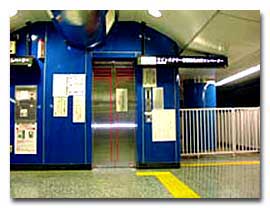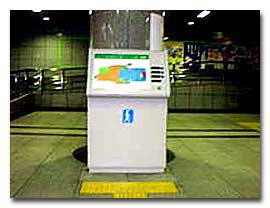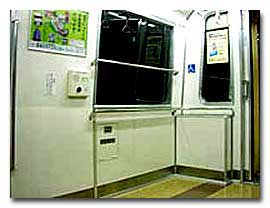Opening New Avenues Towards a Barrier-Free Japan (December. 2001)
An epoch making subway Tokyo's No.12 subway line, which is named the Oedo Line (literally means the "Great Edo Line") started operation in December 2000, more than ten years after construction was first started. Edo is, of course, the old name of Tokyo.
According to the Tokyo

Metropolitan Government, this new subway line has significantly improved convenience for people who live far away from any subway station. Nowadays, with the newly opened Oedo Line, wherever you live in downtown Tokyo, most people can get to nearest subway station within a short 10 minutes walk. The Oedo line has adopted cutting-edge technology such as the linear motor system.
Furthermore, it is reassuring for the residents of Tokyo to know that the station buildings at every station have been designed to withstand a major earthquake greater than the magnitude of the Kobe earthquake in 1995.
All stations are equipped with state-of-the-art anti-disaster surveillance systems with sensors to detect fire and flooding immediately. In the case of an emergency, passengers are evacuated rapidly, while fires are extinguished and smoke is extracted automatically. The Tokyo Government has made tremendous efforts to make this new subway as convenient as possible for all people, especially for elderly and disabled persons.
Disabled-friendly subway


With all the devices that the Oedo line has provided for people, the measures taken for disabled and senior citizens are certainly worthy of note.
Every station has not only elevators and escalators, but also double handrails, guide maps with audio response system and Braille tiles, toilets for wheelchair users. Moreover many of the stations have wider automatic entrance gates, enabling easy passage of people using wheelchairs. You can find the same audio guide maps at the same place in all stations. These standardization measures were often overlooked until now. Once you come to this device you will find out where the exits and facilities of the station, such as toilets and bus connection points, are.
Independent living on the Oedo Lin
Jazz commentator and wheelchair user Yumi Kudo left her hometown in Chiba to start living by herself a year ago. The place she chose to live was Nishishinjuku, one of the busiest areas in Tokyo, along the Oedo Line. "The opening of the Oedo Line has changed my life dramatically. Stations are well equipped. They are easily accessible. I can get to the entrance gate directly by elevator from the ground. Buying a ticket and getting into the train by myself, I settle into the special space for wheelchair users and sit back and relax until I reach my destination," Yumi commented. She is enjoying the subway as the means to get easily to and from work. According to her, among companions using wheelchairs," Think about living by yourself? Think about along the Oedo Line" is getting to be a popular byword.
Challenges
However this subway system is not yet entirely welcoming for individuals who have different disabilities. For example, some blind and visually impaired people feel fear without a conductor in a train and they are demanding a safety wall on the platforms. To make the city more accessible for disabled people who have been stuck in their homes until recently, there are still design and other challenges for all of us to improve the transportation environment.
"Talking Roads" are coming soon
The Ministry of Land, Infrastructure and Transport announced that they are developing voice-guided roads for the visually impaired and for wheelchair users. This navigation system, which is called "talking roads" informs users about upcoming obstacles such as stairs in their way and provides guidance for safer ways to walk.
This intelligent navigation system will be made possible by installing devices under the roads, which transmit signals to personal digital assistants (PDAs) which are like mobile phones. Special white canes or mobile phones are used for antenna. The user can hear the guidance through earphones connected to palm-size computers. To give some examples: through earphones users can hear various kinds of information: "There are stairs coming up," "You are approaching the edge of the platform," "Crossing is right here" etc. If you input the map of the area and your destination to your PDAs, you will be informed where you should turn. This small, smart gadget will guide you in the safest way to your destination.
The Ministry reports they are at an experimental stage right now and will appear in Tokyo and Osaka on a trial basis in the spring 2002 and then will be put into practice in other cities by 2003.
This is one of the challenges under the new legislation enacted in November 2000: "The Law for Promoting Easily Accessible Public Transportation Infrastructure for the Aged and the Disabled." The Ministry plans to install "talking roads" in Improvement Priority Areas, which have railway station with more than five thousand passengers a day.
The new era for accessibility in Japan has just begun. When we take a few moments to look around, we can see that there are many areas for improvement. Full participation for all depends on the ability to go anywhere without hindrance. This is an important step towards a barrier-free world.
